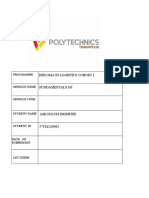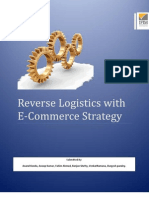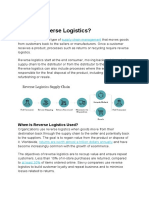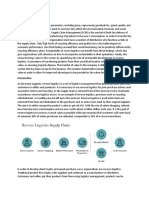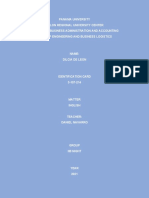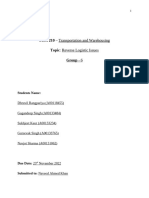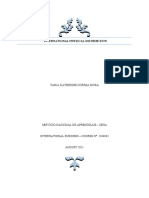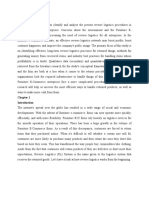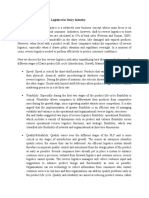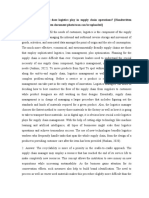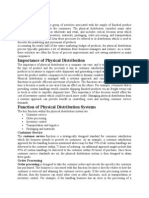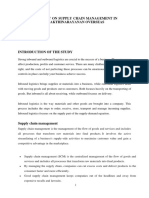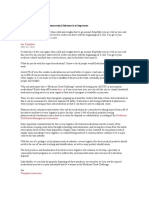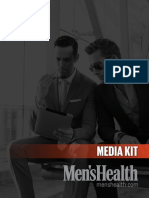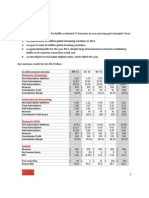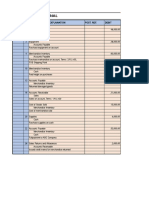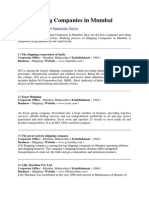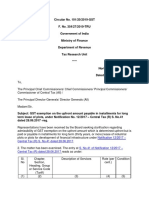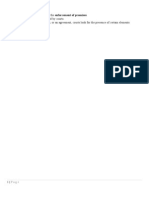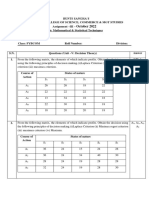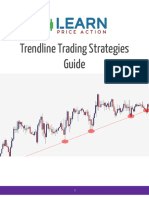Reverse Logistics
Reverse Logistics
Uploaded by
kamelCopyright:
Available Formats
Reverse Logistics
Reverse Logistics
Uploaded by
kamelCopyright
Available Formats
Share this document
Did you find this document useful?
Is this content inappropriate?
Copyright:
Available Formats
Reverse Logistics
Reverse Logistics
Uploaded by
kamelCopyright:
Available Formats
2.
PACKAGING RETURN AND REUSE
In Europe the use of returnable or reusable packaging, often made from steel or plastic, is becoming big business because of the cost of waste disposal. The concept of reusable packaging is based on the idea that companies which manufacture and distribute products should be responsible for cleaning up after themselves. In New Zealand it is catching on in certain areas and, though fraught with complexities, is a concept that companies will be forced to adhere to in the next decade. Packaging reuse and return is easy if there is a short vertical marketing system with a steady predictable demand but it gets complex when there is a series of people in the chain and where the product is deunitised as it moves along the chain; for example, if a product is repackaged and moved from a bulk container to a smaller one. For packaging return and reuse to be successful all partners must cooperate to maximise container use and relationships must be coordinated and controlled. There is increasing interest in outsourcing the management and tracking of containers and for the out-sourced party to organise numerous participants and cost
exchange procedures. Third parties can pull together enough participants to give package reuse and return economies of scale which justify a network of depots and drivers. Studies in Germany show that effective reuse of returnable containers reduces the amount of energy and water consumption and pollution and reduces disposal costs. The downside is that the extra transport involved clogs roads and uses petrol.
Companies which establish reverse logistics programmes, either through a third party or internally, benet through realising return customers and improved nancial returns and enjoy the spin-offs from environmentally sound choices. New Zealand companies are late in recognising reverse logistics as inevitable and have little knowledge of the complexities of it. Those which embrace the concept as a vital part of business processes will gain competitive advantage in the next decade. One of the factors pushing reverse logistics is the number of companies who state 100% satisfaction guaranteed or your money back - no questions asked. Some retailers will only deal with suppliers who are prepared to do business on this basis - if the check out operator is asked to take a product back he/she does, without question, and the supplier must accept this decision. The challenge is to nd a process which will quickly and efciently return the product to either inventory, network, disassembly or disposal. Whilst the objective is to minimise any additional cost US studies show a 12:1 return on any
investment in returned goods. Reverse logistics can be broken down into three separate but interconnected areas.
3. PRODUCT RECALL
Product recall reverses the usual marketing process. The company involved is trying to get the customers to bring products back instead of taking them away. Product recall can be an expensive and distressing process. It is the nightmare which companies pray wont happen to them, particularly when it involves problems with consumer goods which could potentially endanger the customer. It is imperative that product recall is handled quickly, efciently and generously. When it is done well it can actually improve the brands image and increase sales long term. For example, Cerebos Greggs handled its glass-in-the-pickle drama so well that within a few months of the recall it increased its market share through attaining the reputation as a company which cared and could be trusted. The aims of a product recall are to recall the product as quickly as possible to minimise public risk, to get back as many faulty products as possible and
1. RETURNS MANAGEMENT
Returns management involves dealing with returned product quickly and protably. There are three categories which require different handling. x Closeouts are where top quality goods are discontinued or are seasonal or holiday related merchandise. x Surplus is top quality goods which have been overrun, returned or are slow moving merchandise. x Salvage involves goods which are damaged, defective or are customer returns. Returns management can be handled in-house or contracted to a third party, like Stocklink, with specialist expertise in it. For companies with high volume it makes sense to outsource reverse logistics requirements. The third party can offer protable management and control of salvageable goods throughout the secondary retail network.
Benefits of a third party handling reverse logistics
x Software is congured specically for returns management. x Customer satisfaction through having a simple single source process. x Dedicated software allows customers to get credited for returned products promptly. Usually in-house procedures are ad hoc and unfocussed. Credits are often late, a fact which merchants nd frustrating, irritating and time consuming. Clear crediting systems add to customer satisfaction.
x Reduced administration time and costs. x Improved inventory control in that the third party not only manages how and when the goods are returned but also the reasons for the return. x Reduced returns after analysis of the reasons for the return? Returns management can be cost effective in a controlled environment through avoiding disposal costs, transporting and refuse while recovering costs. Besides, as an environmental issue, it looks good for the company.
Options for surplus, salvaged and out-of-season goods
Whether returns are managed inhouse or by a third party there are various options which need to be considered for those goods. x Return to vendor. x Move to another store and sell on. x Donate to charity. x Refurbish and redistribute, eg Telecom xing up returned telephone systems and selling them to technology developing countries. x Salvage sales is a major untapped source of asset recovery revenue. There are systems in place in New Zealand which deal in these goods, eg The Goldmine, other deep discounters and weekend markets. Salvagers keep resaleable merchandise in the consumer chain and if handled sensitively this merchandise does not compete with top quality product. The ea market buyer, and those who shop at the deep discounters,
are not the same consumers who buy top quality goods. For companies which are brand sensitive there are debranding issues which can be handled. x Product destruction is the least desirable option. There is no revenue attached to it, only cost; from transport, destruction and dumping. All these options are likely to involve grading, sorting, reunitising, relabelling or brand de-marking depending on the product and what the client company wants done with it. There are trouble spots in returns management which can and need to be handled with precision and knowledge. If goods are to be salvaged and sold-on the chain of custody must be tightly controlled to avoid the re-returns of goods for full priced refunds. Misrepresentation, where the customer is unaware that the goods are salvage, can create customer dissatisfaction. Specialists in returns management have the skills and contacts to handle these issues.
to minimise cost and inconvenience for the consumer and the company. The procedure is straightforward and logical but it involves coordination of transport, logistics and public relations and needs to happen rapidly. Companies should have an up-to-date recall strategy in place. This strategy could be planned in conjunction with a third party logistics specialist. The advantages of using third party expertise, such as that offered by Stocklink, are that transport logistics, regardless of volume, can swing into action with minimal notice. Using a third party allows the client company to continue with core business while the logistics of the recall are being handled quickly and efciently. The client will also benet from more accurate reporting to meet statutory requirements. The process involves picking up products from point of purchase, bringing them to a depot and ensuring that they are disposed of in such a way that they cant be retrieved from the rubbish. Parts of the product can be removed and recycled, for example glass jars, tin cans, metal or paper. A logistics company, like Stocklink, would dispose of the product, after consultation with the client, in the cheapest and safest way. Stocklink also has software in place to track product recall by numbers and location which gives the client accurate information of the effectiveness of the recall message.
reverse logistics:
The process of managing the return and subsequent re-use or disposal of distributed inventory and its by-products.
You might also like
- Untitled PDFDocument1 pageUntitled PDFKöves Dávid0% (2)
- The Secret of HM Group Success in The Last DecadeDocument21 pagesThe Secret of HM Group Success in The Last Decademico_mihaiNo ratings yet
- Assignmengt 3 SCMDocument3 pagesAssignmengt 3 SCMWajiha KamalNo ratings yet
- LogisticsDocument7 pagesLogisticsPrishneeBNo ratings yet
- Reverse Logistics With E-Commerce StrategyDocument12 pagesReverse Logistics With E-Commerce StrategyRanjan ShettyNo ratings yet
- Reverse LogisticsDocument17 pagesReverse LogisticsMarvellous YeezorNo ratings yet
- Supply Chain End TermDocument17 pagesSupply Chain End TermCHAITRALI DHANANJAY KETKARNo ratings yet
- Green Reverse Logistics Practices2Document4 pagesGreen Reverse Logistics Practices2Joel GwatsvairaNo ratings yet
- Green Reverse Logistics Practices2Document4 pagesGreen Reverse Logistics Practices2Joel GwatsvairaNo ratings yet
- What Is Reverse Logistics?: Supply Chain ManagementDocument9 pagesWhat Is Reverse Logistics?: Supply Chain ManagementAnush RaiNo ratings yet
- Assignment 1 Reverse Logistics Study MaterialDocument42 pagesAssignment 1 Reverse Logistics Study MaterialBabarKalamNo ratings yet
- Returns ManagementDocument15 pagesReturns ManagementMajeed SedaburrNo ratings yet
- A Guide To Reverse LogisticsDocument4 pagesA Guide To Reverse LogisticssanzitNo ratings yet
- Reverse LogisticsDocument7 pagesReverse LogisticsJohniekim MurithiNo ratings yet
- Supply Chain Team 5 (1)Document17 pagesSupply Chain Team 5 (1)nguyentranyennhi160804No ratings yet
- Differences Between Forward and Reverse Logistics in A Retail EnvironmentDocument4 pagesDifferences Between Forward and Reverse Logistics in A Retail EnvironmentsawlaninNo ratings yet
- Reverse LogisticsDocument5 pagesReverse Logisticsshashi singhNo ratings yet
- Reverse LogitsicsDocument9 pagesReverse Logitsicsmerlin masterchiefNo ratings yet
- A Guide To Reverse Logistics - How It Works, Types and Strategies - NetSuiteDocument22 pagesA Guide To Reverse Logistics - How It Works, Types and Strategies - NetSuitepalomaviguzNo ratings yet
- Unit-3 ILMDocument19 pagesUnit-3 ILMkamya saxenaNo ratings yet
- Reverse Logistics in Supply Chain ManagementDocument16 pagesReverse Logistics in Supply Chain Managementmohammad.hamza1701No ratings yet
- Reverse Logistics The Way Forward Part 1 of 2 Codex986Document4 pagesReverse Logistics The Way Forward Part 1 of 2 Codex986NikhilDehlanNo ratings yet
- Key Reverse Logistics Management Elements: GatekeepingDocument2 pagesKey Reverse Logistics Management Elements: Gatekeepingstacy gonzalesNo ratings yet
- InglishDocument10 pagesInglishDilcia D'leonNo ratings yet
- Reverse LogisticsDocument66 pagesReverse Logisticsafiasultana1911No ratings yet
- SCM 210-Reverse Logistic IssuesDocument10 pagesSCM 210-Reverse Logistic IssuesDhruvilNo ratings yet
- Reverse Logistics in Brewing IndustriesDocument3 pagesReverse Logistics in Brewing Industriesarpit guptaNo ratings yet
- International Physical Distribution: Tania Katherine Correa MoraDocument6 pagesInternational Physical Distribution: Tania Katherine Correa Moratania correa moraNo ratings yet
- Scope of Supply Chain ManagementDocument7 pagesScope of Supply Chain Managementali afzaly0% (1)
- Reverse Supply ChainDocument7 pagesReverse Supply ChainDhiren ChaudharyNo ratings yet
- Anam Thesis 22Document59 pagesAnam Thesis 22Ubl HrNo ratings yet
- Key Indicators of Reverse Logistics For Dairy IndustryDocument3 pagesKey Indicators of Reverse Logistics For Dairy IndustryViprasNo ratings yet
- Assignment No 1Document3 pagesAssignment No 1Zainab KhalidNo ratings yet
- Case Study OperationsDocument4 pagesCase Study OperationsIramNo ratings yet
- Team#1 PIA Op - LogísticaDocument32 pagesTeam#1 PIA Op - Logísticaaaxel0702No ratings yet
- Reverse Logistics ThesisDocument4 pagesReverse Logistics Thesistaniaknappanchorage100% (2)
- (2005) Mollenkopf & Closs - The Hidden Value in Reverse LogisticsDocument9 pages(2005) Mollenkopf & Closs - The Hidden Value in Reverse LogisticsindiolandNo ratings yet
- Marketing ManagementDocument24 pagesMarketing Management9715508147No ratings yet
- Prestige Institute of Mangement Dewas: Managing Risk and Returns Akeyto Organization SuccessDocument11 pagesPrestige Institute of Mangement Dewas: Managing Risk and Returns Akeyto Organization SuccessRameez KhanNo ratings yet
- Unit 7 Lesson 1 Logistics NotesDocument6 pagesUnit 7 Lesson 1 Logistics Notesanmitchell586No ratings yet
- Evolution of Closed-Loop Supply ChiansDocument5 pagesEvolution of Closed-Loop Supply ChiansAnnyatamaBhowmikNo ratings yet
- Log 100 GalaneDocument5 pagesLog 100 GalanePhumlani GalaneNo ratings yet
- CH 6 Reverse Logistics PresentationDocument27 pagesCH 6 Reverse Logistics PresentationAnita AzharNo ratings yet
- Reverse Logistics & Competitive StrategyDocument6 pagesReverse Logistics & Competitive Strategychops95luvNo ratings yet
- Chapter 4 SCMDocument9 pagesChapter 4 SCMalynmae2728No ratings yet
- Total Cost-LogisticDocument17 pagesTotal Cost-LogisticTan NguyenNo ratings yet
- Course: Logistics Management Session: Dec 2019: Question No.-1 AnswerDocument5 pagesCourse: Logistics Management Session: Dec 2019: Question No.-1 AnswerRakesh PandeyNo ratings yet
- Course: Logistics Management Session: Dec 2019: Question No.-1 AnswerDocument5 pagesCourse: Logistics Management Session: Dec 2019: Question No.-1 AnswerRakesh PandeyNo ratings yet
- Warehousing TodayDocument3 pagesWarehousing Todaylucia.torremochaNo ratings yet
- SCM 301Document10 pagesSCM 301Manda simzNo ratings yet
- Moving Towards A Sustainable Supply Chain-1720679304010Document23 pagesMoving Towards A Sustainable Supply Chain-1720679304010iFuex businessNo ratings yet
- Key Reverse Logistics Management: Chapter 2: Managing ReturnsDocument35 pagesKey Reverse Logistics Management: Chapter 2: Managing ReturnsRiska muliaNo ratings yet
- Dr. Maram Venkat Ramana Reddy PDFDocument8 pagesDr. Maram Venkat Ramana Reddy PDFDesh Vikas JournalNo ratings yet
- A Study On Supply Chain Management in Sakthinarayanan OverseasDocument31 pagesA Study On Supply Chain Management in Sakthinarayanan OverseasManju ManjuNo ratings yet
- Inventory Management Group WorkDocument10 pagesInventory Management Group WorkSheila JoyNo ratings yet
- Reverse Logistics DissertationDocument6 pagesReverse Logistics DissertationOrderPaperOnlineUK100% (1)
- Reverse LogisticsDocument4 pagesReverse LogisticsLateralus LateralusNo ratings yet
- Dropshipping: Make Money Online & Build Your Own Dropshipping Business (Step-by-step Instructions for Starting E-commerce Business and Making Money Online)From EverandDropshipping: Make Money Online & Build Your Own Dropshipping Business (Step-by-step Instructions for Starting E-commerce Business and Making Money Online)No ratings yet
- Products that Last: Product Design for Circular Business ModelsFrom EverandProducts that Last: Product Design for Circular Business ModelsNo ratings yet
- Tata Motors Nano To Roll OutDocument4 pagesTata Motors Nano To Roll OutSymon StefenNo ratings yet
- Schedule LevelsDocument4 pagesSchedule Levelsferdie14No ratings yet
- Ibm ProspectusDocument8 pagesIbm ProspectusShelly AgarwalNo ratings yet
- 17-003 MK Media Kit 17Document36 pages17-003 MK Media Kit 17Jean SandiNo ratings yet
- Netflix 4Q 2012 Investor LetterDocument17 pagesNetflix 4Q 2012 Investor LetterofficialklsNo ratings yet
- Journal Entries & LedgerDocument16 pagesJournal Entries & LedgerdelgadojudithNo ratings yet
- Case Study 2 - AppirioDocument11 pagesCase Study 2 - Appiriojycm2001No ratings yet
- Career Focus WorksheetDocument2 pagesCareer Focus Worksheetapi-369601432No ratings yet
- 2010dec23 - Howard Griswold Conference CallDocument32 pages2010dec23 - Howard Griswold Conference CallGemini ResearchNo ratings yet
- Shipping Companies in MumbaiDocument5 pagesShipping Companies in MumbaiKamlesh SoniwalNo ratings yet
- Ratio Analysis On Optcl, BBSRDocument47 pagesRatio Analysis On Optcl, BBSRSusmita Nayak100% (1)
- Beginning Java EE 7 NotesDocument9 pagesBeginning Java EE 7 NotesSilentSkyTATNo ratings yet
- CGST CircularsDocument431 pagesCGST CircularsRohan KulkarniNo ratings yet
- Chapter 2-The International Monetary SystemDocument52 pagesChapter 2-The International Monetary SystemHay Jirenyaa100% (1)
- Annexure C Report (12) ICTDocument2 pagesAnnexure C Report (12) ICTSaqib XamNo ratings yet
- Chapter 2-Offer and Acceptance ConclusionDocument52 pagesChapter 2-Offer and Acceptance Conclusionapi-234400353100% (1)
- Lets Talk About Work Fun Activities Games 4485Document1 pageLets Talk About Work Fun Activities Games 4485Iris Fatia MaharaniNo ratings yet
- A Study On MIGA (Multilateral Investment Guarantee: Agency)Document26 pagesA Study On MIGA (Multilateral Investment Guarantee: Agency)Pallavi Agarwal100% (2)
- 2017Document75 pages2017AnnaMarielAringoNo ratings yet
- CMP: Rs. 444 Weight:7%: Dilip Buildcon LTDDocument9 pagesCMP: Rs. 444 Weight:7%: Dilip Buildcon LTDMehran AvNo ratings yet
- Damri AR 2019Document354 pagesDamri AR 2019TITA ANJARNINGSIH 1No ratings yet
- Ronquillo, Ramainne Chalsea L.-Sec1 - MaximizationDocument4 pagesRonquillo, Ramainne Chalsea L.-Sec1 - MaximizationRamainne RonquilloNo ratings yet
- Strategic Management - Strategic Management InsightDocument6 pagesStrategic Management - Strategic Management InsightAsteraye WakaNo ratings yet
- Undergraduate Research Proposal FormDocument99 pagesUndergraduate Research Proposal FormGeorge BaternaNo ratings yet
- Fybcom Sem-I Assignment - Unit - VDocument3 pagesFybcom Sem-I Assignment - Unit - VSufiyan MominNo ratings yet
- IV - 2 TLE Second Periodic ExamDocument2 pagesIV - 2 TLE Second Periodic ExamAngelica BarangayNo ratings yet
- Tatu City UpdateDocument1 pageTatu City UpdatePro AkinNo ratings yet
- Trendline Trading Strategies GuideDocument12 pagesTrendline Trading Strategies GuideChan Ders100% (6)



